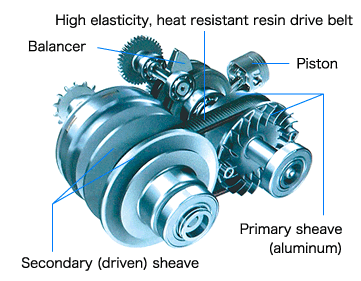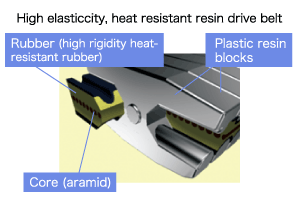Yamaha Motor Co., Ltd. has succeeded in the development of a continuously variable transmission (CVT) named Y.C.A.T. (Yamaha Compact Automatic Transmission) that is compact enough to be mounted on a moped type motorcycle of the 100 to 125cc class.
In addition to displaying this Y.C.A.T. system at the 41st Tokyo Motor Show 2009, it will appear on new moped type models for the ASEAN market beginning with a 2010 model in Vietnam.
Y.C.A.T. is a system that greatly reduces the size of the CVT units proven in use on scooter models and fits the drive belt that connects the engine drive shaft and rear wheel axle inside the engine assembly to make possible an automatic transmission motorcycle with the same exterior appearance as a moped. This system has been made possible by (1) sheaves designed for optimum performance with the high elasticity, heat resistant resin drive belt and (2) an optimum cooling system design for the unit. With this system it is now possible to fit an automatic CVT on the space occupied by the manual transmission on a conventional moped type motorcycle, thus increasing the freedom of design and making it possible to combine the multipurpose utility of a moped with the ease of use of an automatic model. With Y.C.A.T. it has been possible to reduce the distance between the primary (engine-side) and secondary (driven-side) sheaves to about 40% of the distance on a conventional commuter CVT and shorten the belt also to about 60% the length, thus helping to make the overall power unit more compact. The size of the entire Y.C.A.T. unit is small enough to fit inside a crankcase virtually no larger than that on a conventional moped.
|
 |
Structure of Y.C.A.T.
|
Y.C.A.T. Merits
1) Enables a more compact unit than conventional CVT for commuter models
2) Increased freedom of chassis design (improved on-board comfort with elimination of shift pedal)
3) Good response resulting from the adoption of the high elasticity, heat resistant plastic resin drive belt
and improved drive force efficiency (20% improvement for the engine alone vs. rubber belt)
|
|
The total motorcycle market demand for the five ASEAN countries of Indonesia, Vietnam, Thailand Malaysia and the Philippines is presently on the level of approximately 10.55 million units (2009 estimate), with most of the demand in the 100cc to 125cc class. Within this market, the popularity of CVT models like the NOUVO introduced by Yamaha Motor in 2002 has grown, but the popularity of the conventional moped type models (17-inch wheels front/rear and manual transmission) remains strong. The reasons for the popularity of mopeds are the assurance riders feel in their ride and their utility in areas like the capacity for carrying considerable loads. This is why mopeds continue to account for about 60% of the total motorcycle market demand (Yamaha survey). And, because of the fact that all the family members of riding age share the use of a moped, there is a call from many customers for automatic transmission moped models. The Y.C.A.T. system was developed to answer this need for a new-generation model that combines the utility and running performance of a moped with the ease of use of an automatic transmission.
|
|
In a scooter or commuter bike CVT, the engine-side sheave (pulley) and rear wheel-side sheave are connected by a belt on the rear arm assembly. Because this system provides step-less variation in transmission ratio, it achieves smooth running and is thus an ideal drive system for a commuter bike. However, in order to dissipate the heat that builds up due to friction between the belt and the sheaves, cooling air is inducted into the belt chamber and a certain amount of belt length is required to provide even, effective cooling.
To deal with this, Yamaha Motor focused on the belt material and structure and the characteristics of the sheaves. Repeated analysis and running tests were conducted to solve the heat problem and produce a compact CVT unit.
|
|
1) Optimum design of a high elasticity, heat resistant plastic resin drive belt and sheaves
 The high elasticity, heat resistant plastic resin drive belt combines a series of 166 plastic resin blocks (with a horizontal "H" cross-section) and belt core sections of aramid fibers encased in rubber. The plastic resin blocks provide firm hold against the sheave (thrust force) while the core provides the revolving strength (drive force transmission), this new belt achieves excellent durability (twice as durable as a rubber belt according to Yamaha test data), outstanding drive response due to the high elastic tension and contributes to good fuel economy.
In addition special sheaves were developed anew for the Y.C.A.T. system to achieve the optimum performance with the system's belt with regard to the cooling performance necessary during high belt load when high rpm presses the belt tightly against the sheaves. A die-cast aluminum sheave is adopted on the engine side and it is chrome plated to ensure sufficient hardness and the surface is processed with micron-level precision for optimum performance. The driven sheave is stainless steel and also designed with micron-level precision to achieve optimum surface texture to ensure outstanding transmission of drive force and good affinity with the belt.
2) Belt chamber designed for stable performance of Y.C.A.T.
The Y.C.A.T. system is designed with a belt chamber that actively draws in air from the outside to ensure an efficient flow of air in the belt chamber to promote cooling of the belt and sheaves. This enabled efficient cooling without the adoption of any special cooling device. Also the shapes of the intake and exhaust ducts have been optimized to minimize intake and exhaust noise.
|

|